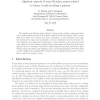Free Online Productivity Tools
i2Speak
i2Symbol
i2OCR
iTex2Img
iWeb2Print
iWeb2Shot
i2Type
iPdf2Split
iPdf2Merge
i2Bopomofo
i2Arabic
i2Style
i2Image
i2PDF
iLatex2Rtf
Sci2ools
TCS
2011
2011
Algebraic aspects of some Riordan arrays related to binary words avoiding a pattern
We consider some Riordan arrays related to binary words avoiding a pattern p, which can be easily studied by means of an A-matrix rather than their A-sequence. Both concepts allow us to define every element as a linear combination of other elements in the array; the A-sequence is unique and corresponds to a linear dependence from the previous row. The A-matrix is not unique and corresponds to a linear dependence from several previous rows. However, for the problems considered in the present paper, we show that the A-matrix approach is more convenient. We provide explicit algebraic generating functions for these Riordan arrays and obtain many statistics on the corresponding languages. We thus obtain a deeper insight of the languages L[p] of binary words avoiding p having a number of zeroes less or equal to the number of ones.
| Added | 15 May 2011 |
| Updated | 15 May 2011 |
| Type | Journal |
| Year | 2011 |
| Where | TCS |
| Authors | Donatella Merlini, Renzo Sprugnoli |
Comments (0)

